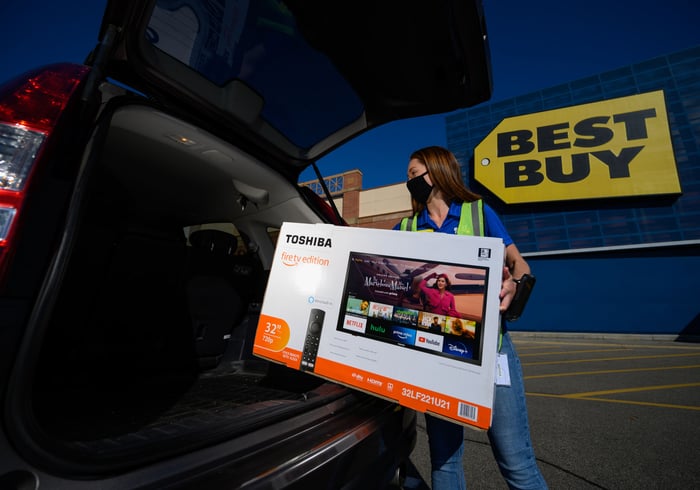Growing inventories, continued inflation, the rising costs of transportation, delivery, and keeping store shelves fully stocked -- these have been the main stories for retail stocks thus far in the earnings season. A combination of these factors contributed to the shrinking profit margins and massive earnings misses for Target (TGT -0.54%), Walmart (WMT 0.57%), and Abercrombie & Fitch (ANF 0.31%) these past two weeks.
Yet some way, somehow, Best Buy (BBY 1.09%) seems to have largely dodged these bullets. Let's take a closer look to find out how.

Image source: Best Buy.
When Best Buy reported its first quarter earnings on Tuesday, it was clear that not everything has gone perfectly for the electronics superstore chain. In contrast to the year-ago quarter, when same-store sales grew 37% year-over-year, this time around that metric declined by 8%. Total sales for the quarter also fell, down about 8.6% year-over-year. Best Buy's profits dropped precipitously, down 35.8% to just $1.49 per share. However, it's worth noting that this decline was largely due to the absence of a $0.47 per share tax benefit that boosted earnings a year ago.
And yet, while Best Buy did mention it suffered "increased promotional activity and higher supply chain expenses" in Q1, management explained that it had anticipated and planned for this; therefore, the higher costs didn't come as a surprise. Transportation costs weren't a big enough problem to make it into Best Buy's earnings release, and were only briefly mentioned as contributing to the "higher costs of goods sold" in the after-earnings conference call.
So how did Best Buy dodge the bullet that hit other retailers so hard this quarter?
CEO Corie Barry praised her team for doing "an amazing job actively managing inventory levels," which the CEO described as "healthy." Too-large inventories can be a problem in retail, as styles go out of fashion (in clothing) or products grow obsolete (in electronics). But at Best Buy, inventories grew only 9% year over year -- not ideal for a quarter in which sales declined 9%, but nowhere near as large as the 32% leap in inventories at Walmart, for example. Indeed, when you consider that Barry described Best Buy's "inventory balance" last year as "unusually low," a little bit of inventory growth this year was actually probably a good thing.
All that being said, Best Buy's free cash flow in Q1 did still go negative -- just as it did at Walmart and Target last week -- due to an increase in spending both on inventories and on accounts payable. As a result, Best Buy's cash profits for the past 12 months have now fallen below $1 billion -- and less than half of its reported net income.
I do believe Best Buy is doing a good job managing a tough economy. That being said, with its current valuation of 17 times free cash flow and sales shrinking for the second straight quarter, Best Buy stock no longer looks like quite as good a buy as it did before earnings.




